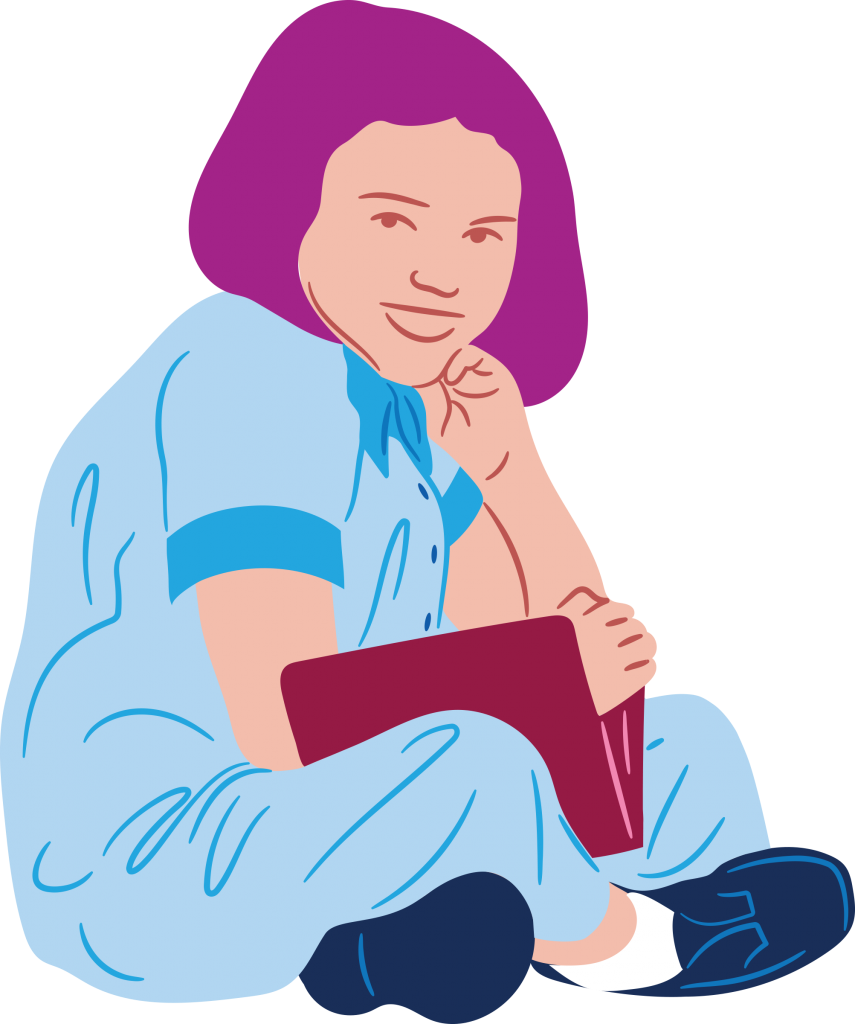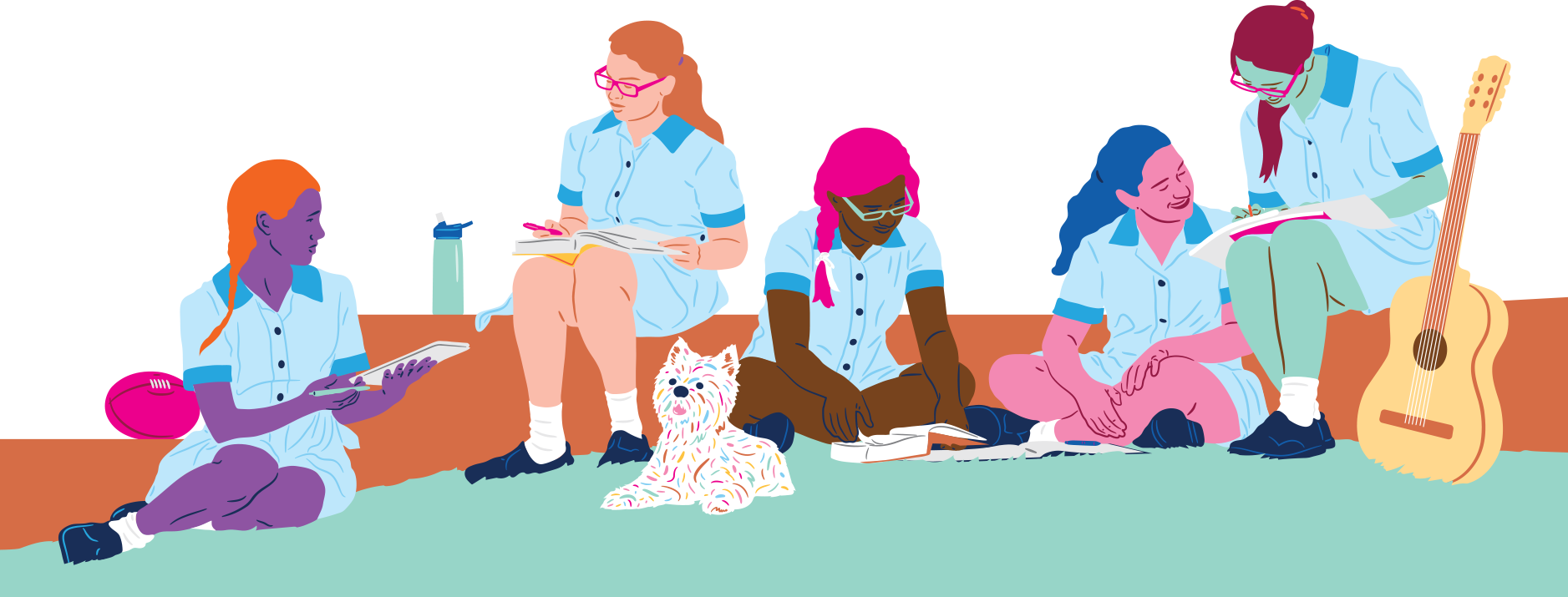Mrs Dunwoody shares a very special gift that the Art Department has presented to the School.
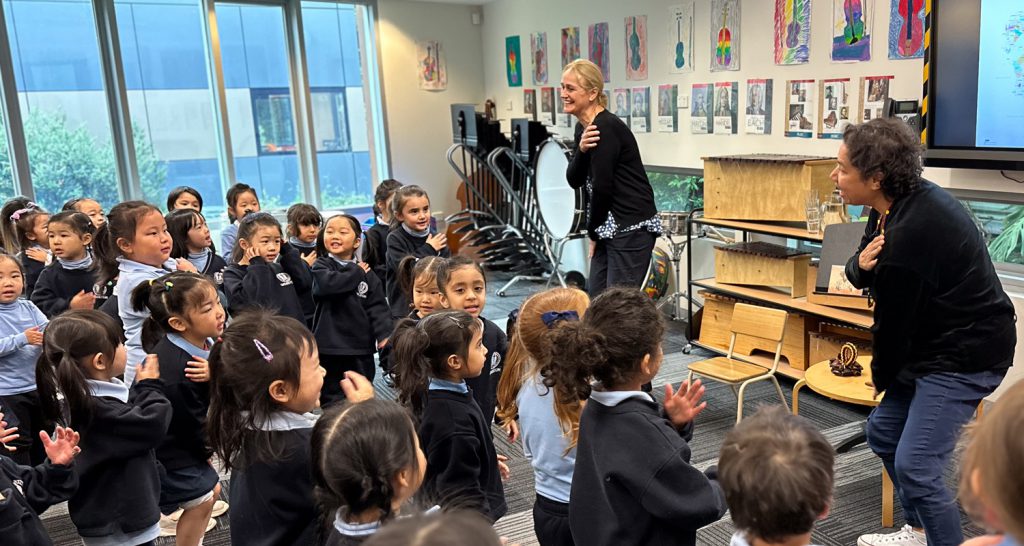
This year Camberwell Girls Grammar School was invited by local Kew MP Jess Wilson to attend an ANZAC Day Service Dawn Service at the Kew RSL on Cotham Road.
As a result of this invitation, our Ormiston School Captains, Kaylee P and Alice X represented CGGS at this important annual event. This dawn service was an opportunity for local schools and dignitaries to lay a wreath at the special memorable site at Kew RSL.
Both Kayle and Alice laid a wreath to show respect to men and women who represented our country in wars and battles from the past. Many prayers were read out by representatives from the RSL, State and local politicians and members from the local Kew community.
I would like to thank Kaylee and Alice’s parents for allowing them to join in this memorable event. Over 2,000 people attended the Service which was an outstanding effort from the local community.
In the future, we hope Camberwell Girls Grammar School can be actively involved in this special annual ANZAC Day Dawn Service.
Paul Donohue
Head of Junior School

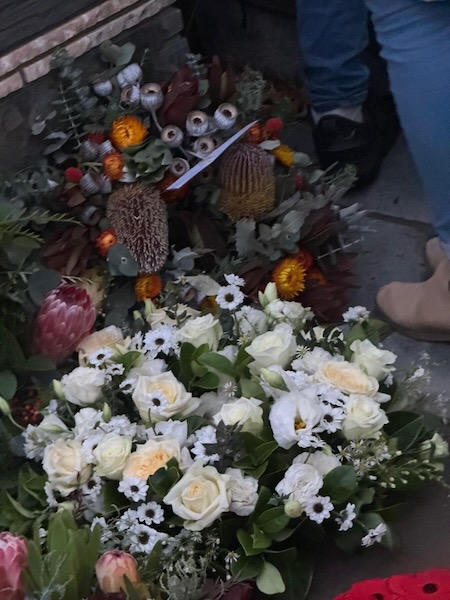
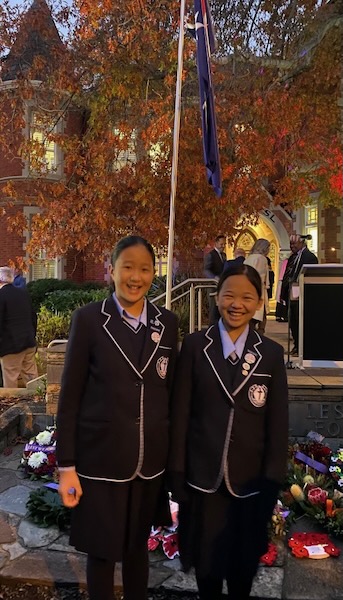
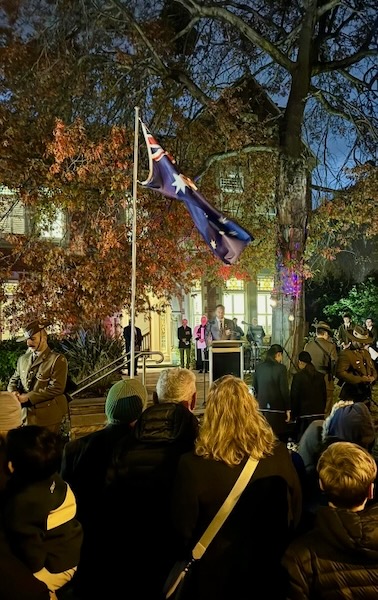
In continuing to strive towards embedding Aboriginal and Torres Strait Islander perspectives into learning and play, the Early Learning students and teachers warmly welcomed Aboriginal and Torres Strait Islander musician Jessie Lloyd known for the Missions Songs Project, on Thursday, May 2nd, 2024.
In partnership with the University of Melbourne and the Department of Education and Training, Jessie Lloyd has developed online modules for primary school music programs, and as an extension has been interested in developing further resources and lessons for the early years. The ELC was fortunate to be part of this interactive workshop focused on teaching Aboriginal and Torres Strait Islander histories and cultures through songs, dancing, and storytelling.
During the workshop, the children, and teachers, along with Murrundindi, Mrs Dunwoody and Mr Donohue, participated in listening, singing and dancing about an Acknowledgment of Country; the Aboriginal and Torres Strait Islander flags, their colour and symbolic significance; Jessie’s family, her language (Kala Lagaw Ya) and her culture; the kinship of songs, beloved by the ELC including Inanay Gupu Wana and Taba Naba; and instruments such as the clapping sticks and kulub.
As reflective learners, the children engaged in capturing their initial thoughts and insights from the session. This is the beginning of many discussions, sharing of songs and extension of learning that will occur across the ELC in the weeks and terms to come.
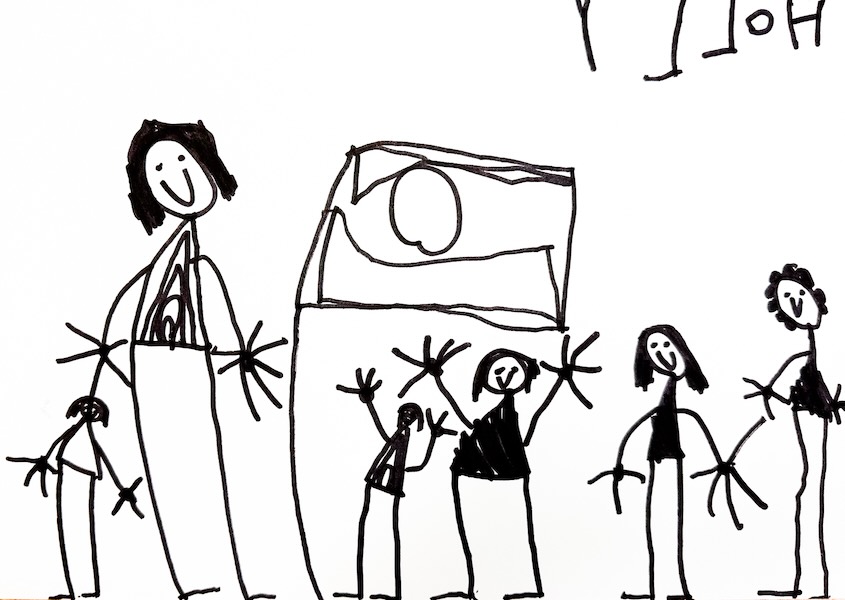
Holly – This is Ms Esther, this is me and this is Viaana, this is Sophie and Bella, and Amber. There is a flag, the Aboriginal flag – the yellow is the sun, the black is people, and the red is the land. Jessie said the black needs to be at the top. She sang a song about the flag. It was peaceful and it made my heart calm.

Chloe – This is the TV [,it showed] the map of Australia, and the people that live on it. This is Jessie and this is Emily, they are singing and playing the guitar. They are teaching us lots of things about Aboriginal and Torres Strait people.
A huge thank you to Jessie for sharing her stories and music with us.
Esther Wong
Early Learning Coordinator
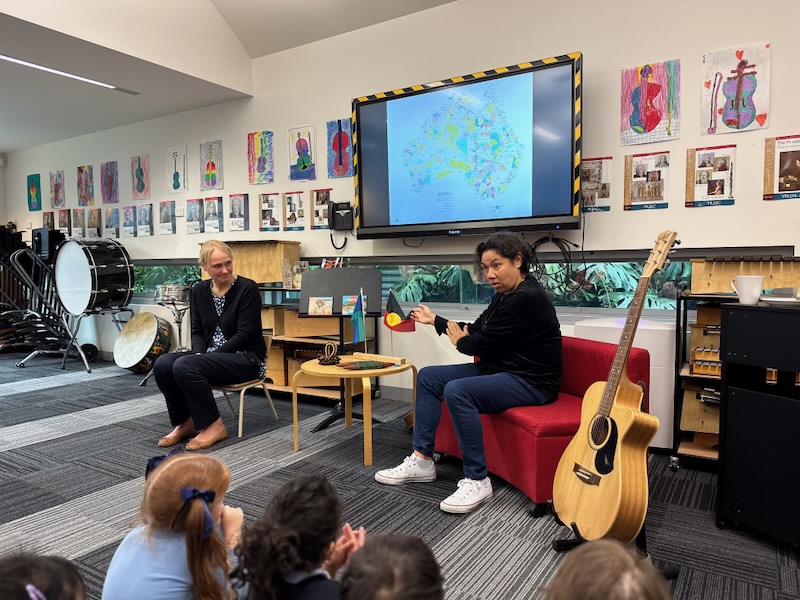
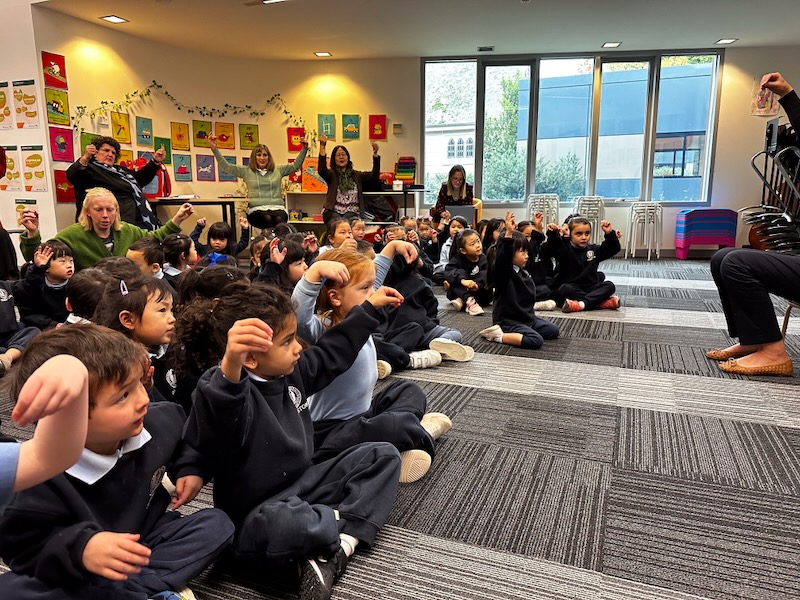

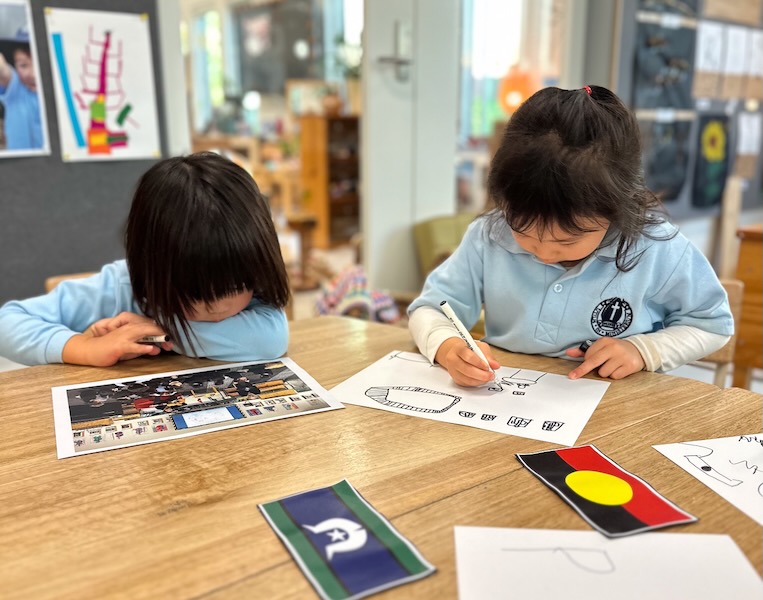
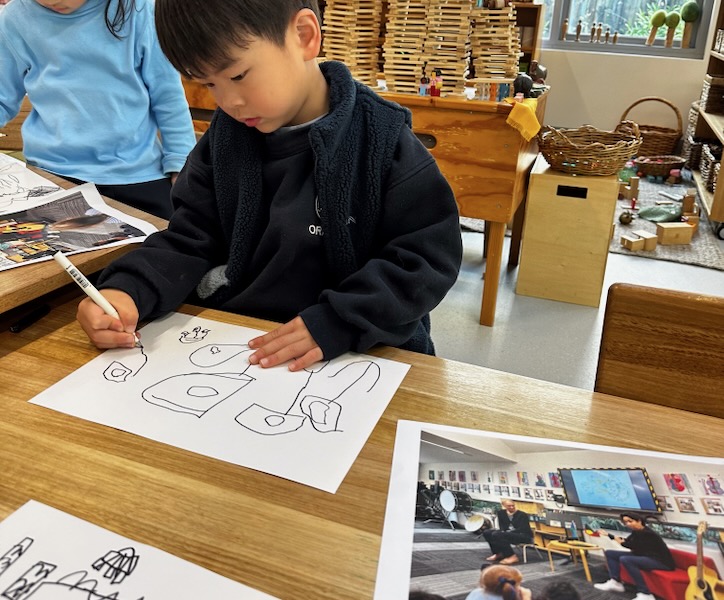
“It seems to me that the natural world is the greatest source of excitement; the greatest source of visual beauty; the greatest source of intellectual interest.” David Attenborough
As environmentalists and curious learners, the children in the Early Learning 4 Full Time class, observed closely and noticed the changes that have occurred, so far, during the season of autumn. The children responded with wonderment and awe as they observed that the leaves on the trees had changed from green to orange, brown and yellow. The children were given time and opportunity to ‘be still’ and observe the leaves on the trees and then watch the leaves as they moved slowly to the ground.

As collaborators and curious learners, the children actively looked for leaves in all parts of the garden – under trees, in tanbark, between the bamboo, amongst foliage and between rocks around the dry creek bed – and placed the leaves into a basket.
As mathematicians, the children focused on different attributes as they collected autumn leaves, for example, some children collected leaves that were yellow – one attribute, whilst others collected leaves that were yellow and pointy – two attributes, and some children collected leaves that were big, yellow, and pointy – three attributes.
The children used their mathematical understandings as they compared the length and shape of the leaves, sorted them based on colour, ordered them according to size, and identified their similarities and differences. The children also had time and opportunity to make connections between counting sequences and the number of leaves.
As self-managers, the children worked with focus and concentration as they observed the details on the leaves. The children used drawing and dialogue to represent and express their observations and thinking. A black marker was used so the children could focus on the line and form of the leaf. These drawings led the children into new and unexplored areas of leaves – parts of a leaf – which enhanced their vocabulary and verbal expression, for example, midrib, petiole, margin, tip, and stem.

Vivaldi’s The Four Seasons – Concerto No. 3 Autumn provided a provocation for exploration of autumn during movement and dance. As creative and imaginative artists, the children used scarves to represent leaves moving in the wind and falling from trees. As mathematicians we also incorporated positional language – high, low, top, bottom, front, behind and side.
It is through these experiences that children develop dispositions for learning such as curiosity, creativity, imagination, and a sense of wonder and awe. They’re also learning about inquiry and being researchers and investigators and discovering that when they take the time to closely observe things from nature, they will notice things they have not previously seen. These experiences also provide opportunities for the children to express their learning, observations, and findings, through multiple languages such as drawing, dialogue, movement, and music.
Angela Follacchio
Early Learning 4 Full Time Teacher
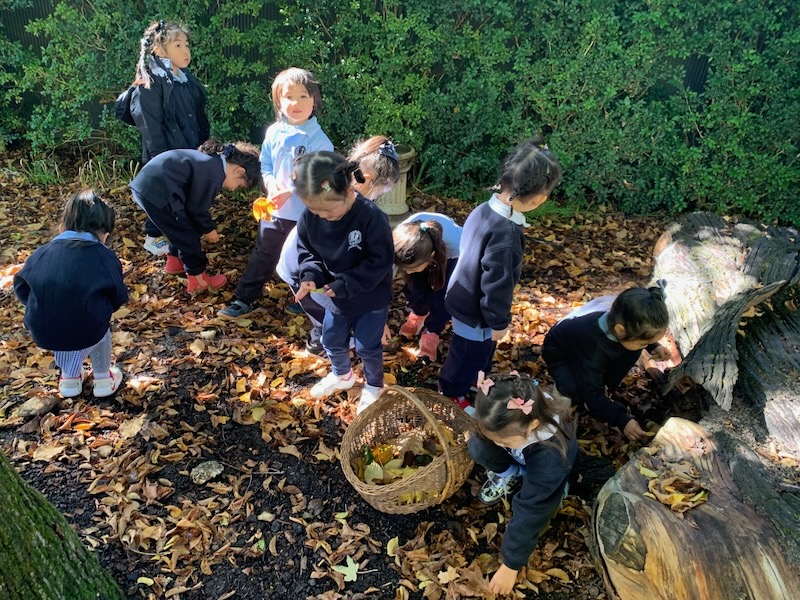
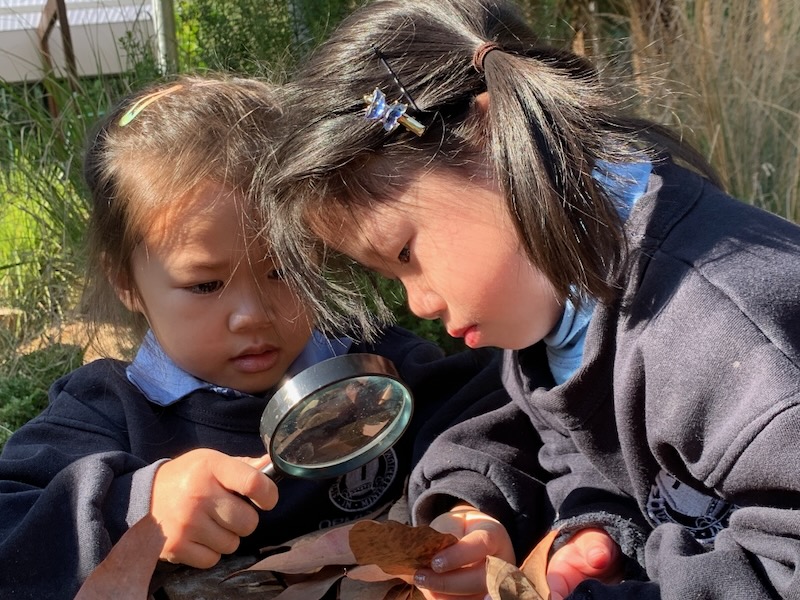

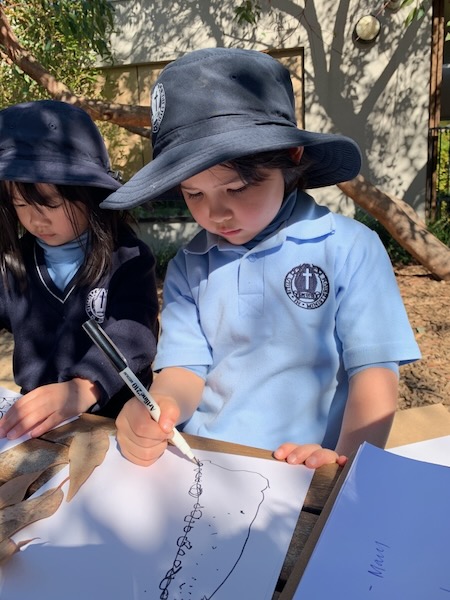
This term, Year 1 students have been exploring the structure of our counting system and exploring the counting sequence, through a series on hand-on and independent learning experiences. The students learnt that the Odometer Principle refers to a set of digits (0-9) that can be used to represent all the numbers in our counting system. Using their collaborative skills, students created a number chart beyond 100 and looked for different number patterns. They identified skip counting patterns, noticed similarities and differences in numbers, and used language such as larger, smaller, before and after, and many students applied their understanding to count larger numbers. They then made connections to their knowledge of place value when using a number line and identified missing numbers. There was much joy when the students were victorious in a game of Beat the Teacher!
Angela Columbine
Year 1 Classroom Teacher
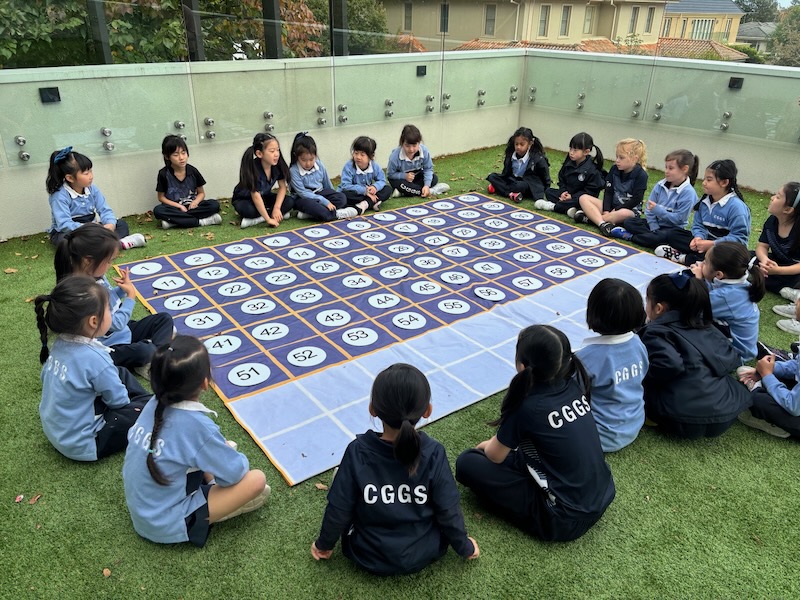
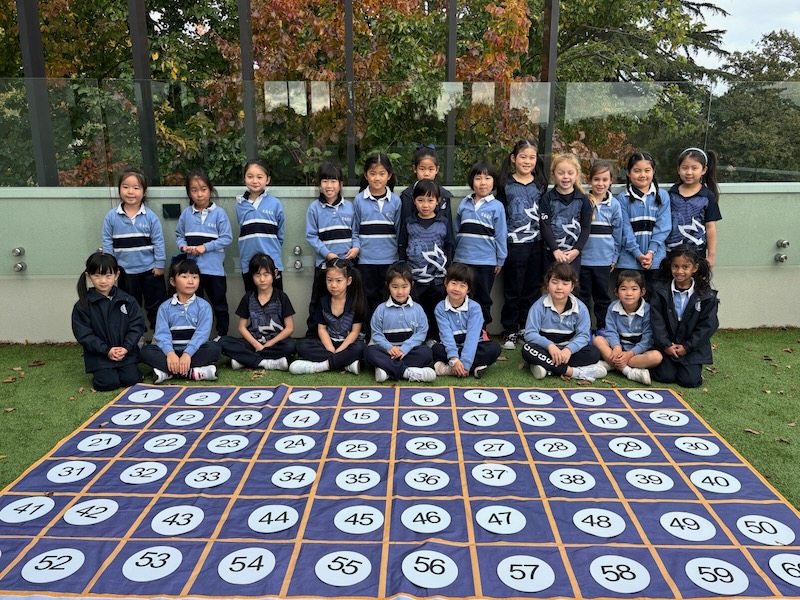
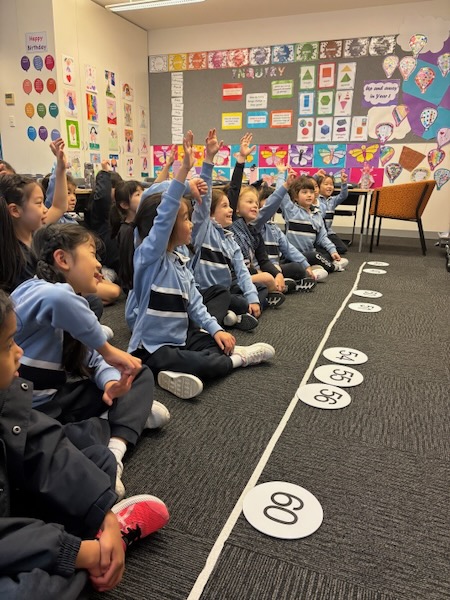


This year, our Year 2 Chinese Heritage class has been exploring the natural world with a focus on the seasons. In Term 1, the students learned about a Chinese fairy tale, vividly describing each season in Chinese and drawing their interpretations. Through sharing their understanding and creativity, they have continued to develop their storytelling skills.
In Term 2, our theme is ‘Insects.’ Throughout this term, students will deepen their understanding of nature by exploring the fascinating world of insects while learning Chinese. We aim to further develop students’ expressive language skills and writing through practical activities and discussions. We are excited for a new term filled with meaningful learning experiences.
Cathy Yue
Chinese Teacher
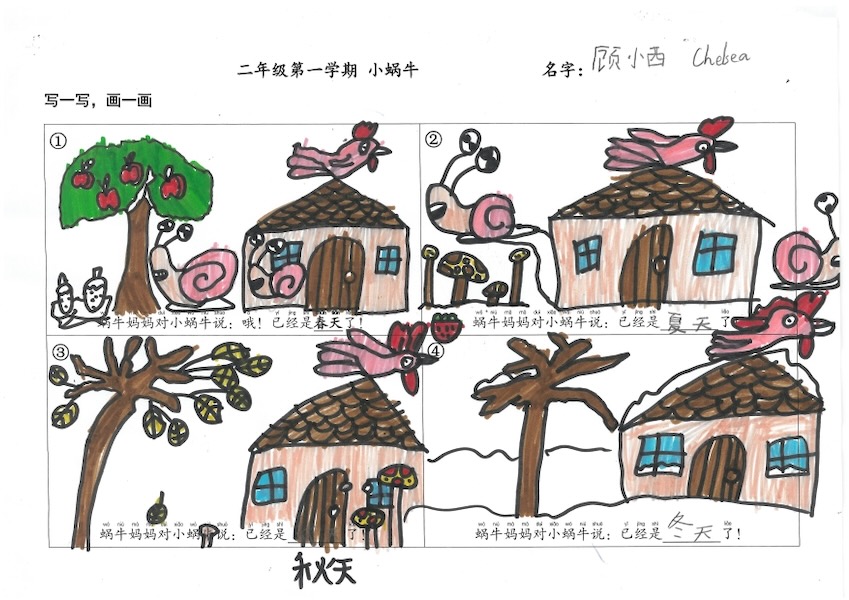


The Year 5 students travelled back in time to the colonial days of Australia’s past.
During our first education session, the students explored many aspects of daily life during the Gold Fever. Taking on different roles as we investigated the Eureka Stockade, some students searched for ‘gold’ and had the rights of ‘diggers’, whilst other students represented the ‘troopers’ and had the authority to check their gold licenses or arrest the ‘diggers’. Ms. Soci dressed as Peter Lalor as the ‘diggers’ fought for the democratic rights to vote on new laws.
Other educational sessions included a theatre session that explored the complex issue of racism and the treatment of Chinese migrants in Ballarat. An additional session looked at the Indigenous perspective of life before, and after, the Gold Rush. There were discussions around different artefacts, the treatment of Indigenous people and how the landscape changed before, during and after the Gold Rush.
Students explored some of the dangers that the ‘diggers’ faced, such as being trapped underground by falling rocks or by water, as they visited the Red Hill Mine Tour. Students learnt about the poor health conditions and difficult environment that were faced daily.
The students had a wonderful day enriching their understanding of key learning from the curriculum. Several members of the public commented on the exceptional behaviour of our students as we explored Sovereign Hill, giving credit to their politeness and manners.
Craig Goodwin
Year 5G Classroom Teacher


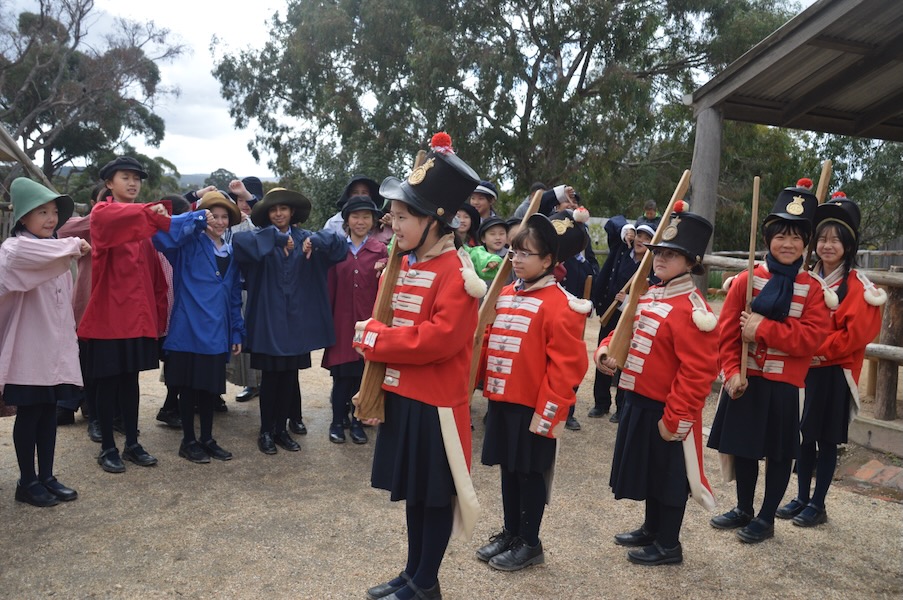
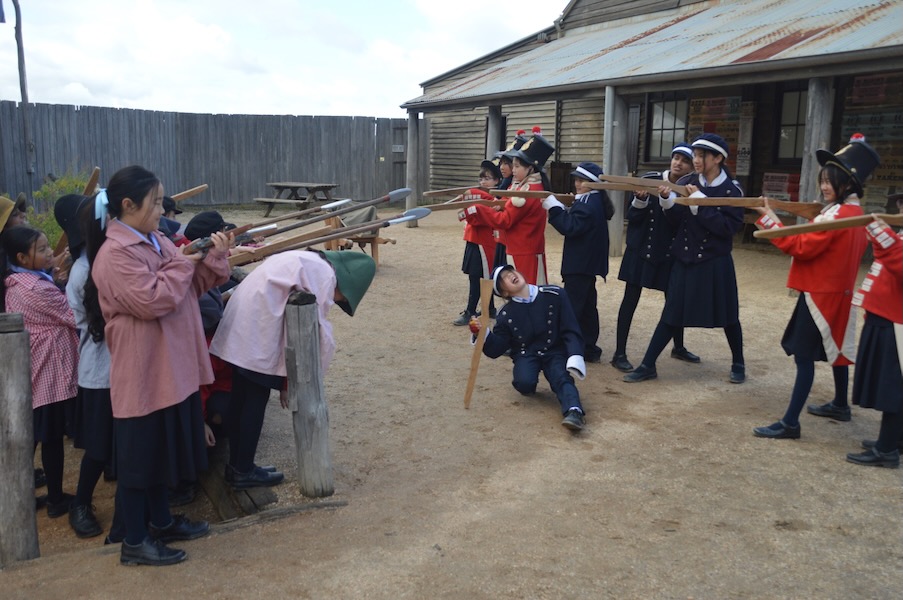
At the end of Term 1, the Year 5 and 6 students went away for camp to CYC Phillip Island Adventure Resort. It was a breath-taking experience of a lifetime, packed with multiple fun activities such as the Twin Flying Fox, Archery, The Giant Swing and more. It took a reasonably long time to get there. The bus was a success because no one got travel sickness.
After we arrived, we all took random bags and piled them onto the grass, in front of our cabins. Everyone was very excited to begin our adventure.
After spending half an hour in our cabins and exploring the area, it was time to begin our first activity! For group three, their first activity was the Initiatives course then the Twin Flying Fox. Additionally, group four’s first activity was Archery then Initiatives Course.
The food was delicious, serving fish and chips, make your own burgers and wraps, and dessert every night. Plus, mouth-watering bakery goods for morning and afternoon tea, such as chocolate cake, Anzac slices, and sometimes even zooper doopers.
All in all, our camp experience was an amazing event for the Year 5 and 6’s.
Written by Caitlyn L, Emma Z, Lucy W and Kenolee H
Year 5 students
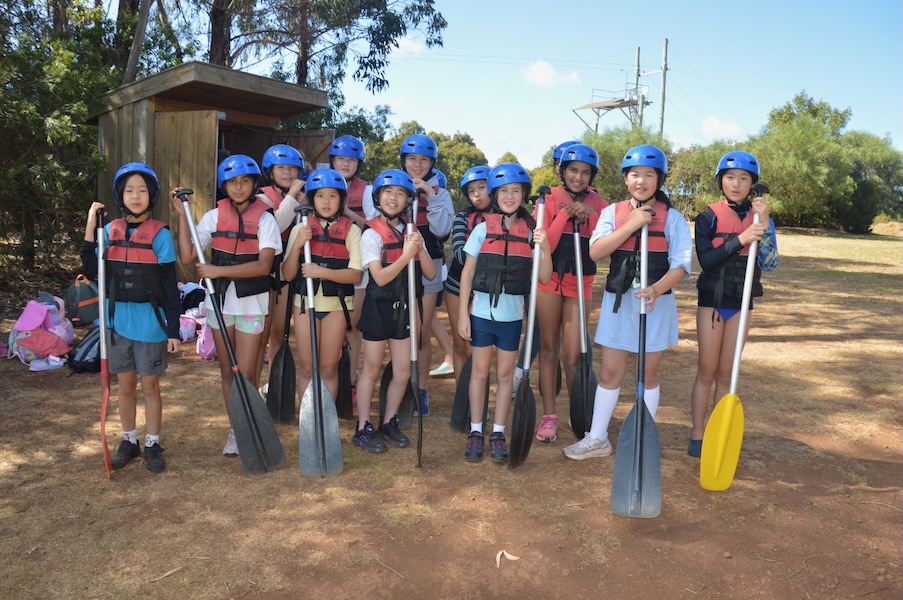
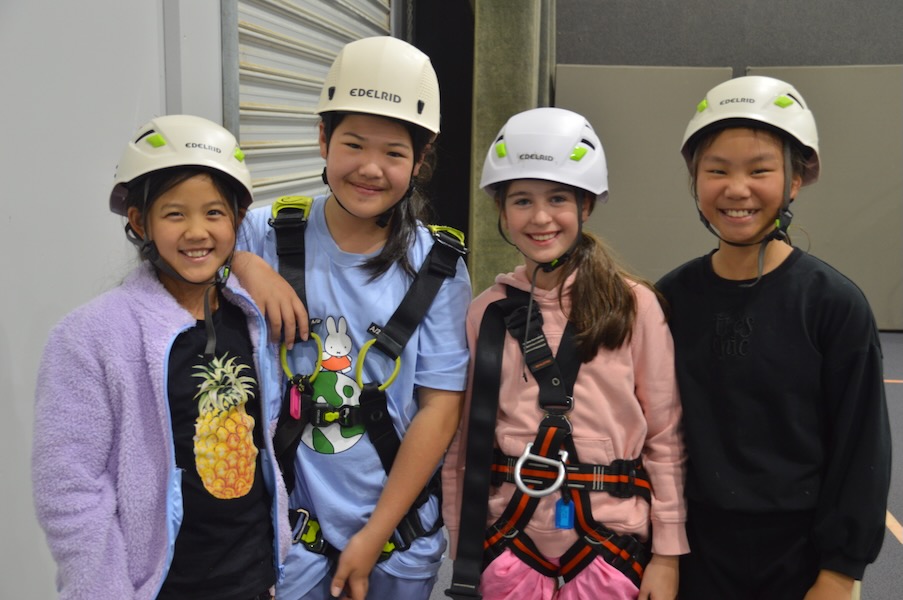
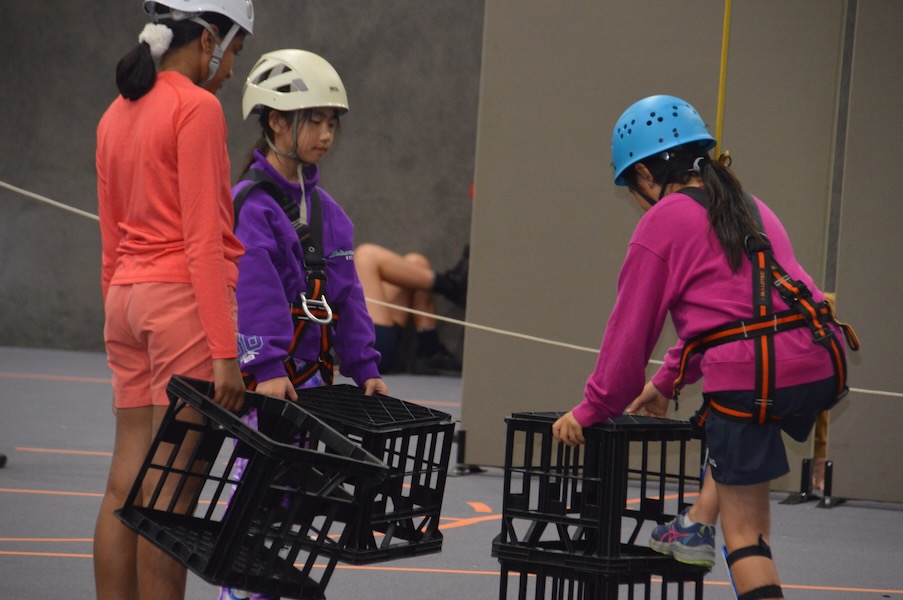
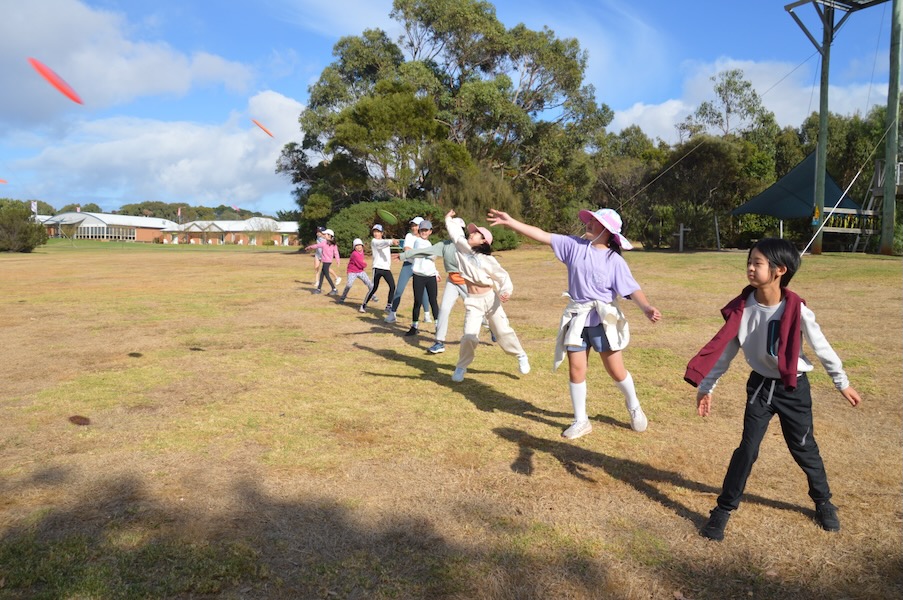
At Junior School, students are immersed in learning experiences that are designed to build their skills and understandings, while also helping them to discover their strengths and passions as learners. Across the curriculum children are challenged to develop transferrable skills that they will need to be successful lifelong learners.
One of the key transferrable skills students focus on building in all year levels is communication. While developing content knowledge is important, it is equally important that all students develop the capacity to effectively communicate their thoughts, understandings, and experiences. In all year levels teachers explicitly plan for opportunities for students to develop their oral, written and multimedia communication skills for authentic audiences. Students learn about the importance of body language, tone, vocabulary choices, clear structure, audience and purpose.
We are extremely proud of our Year 6 leaders, who are excellent exemplars of our students being quality communicators. In their new leadership roles, Year 6 have choice and voice in how they run their roles. The leaders have stepped up to the challenge of communicating effectively through emailing and running meetings with their leadership mentor teachers, coordinating events related to their roles, and regularly taking on the challenge to lead most aspects of our Junior School Assemblies. It is exciting to see how well our Year 6 leaders are purposefully developing their communication skills and we can’t wait to see what they achieve by the end of the year.
Emma Hinchliffe
Deputy Head of Junior School
Mrs Dunwoody shares a very special gift that the Art Department has presented to the School.
Excursions, competitions, music and sporting achievements—it's been a busy fortnight.
The Year 3 to 6 students are still buzzing after last night's Choral Concert at St Mark's Church.
The Year Level Representatives have organised some fantastic activities recently, including a 'Paint and Sip' class!
We acknowledge and pay respect to the Wurundjeri people as the traditional custodians of the land on which the school is situated.
Secondary School / Administration
2 Torrington Street, Canterbury
Victoria 3126 Australia
T +61 3 9813 1166
F +61 3 9882 9248
camgram@cggs.vic.edu.au
Junior School / Ormiston
